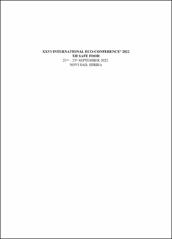Load of soil, food, animal feed and biological material with radioactive residues

View/
Date
2022-09-21Author
Mihaljev, Željko
Živkov-Baloš, Milica
Jakšić, Sandra
Popov, Nenad
Metadata
Show full item recordAbstract
The uses of nuclear energy for peaceful purposes (nuclear weapon testing, nuclear reactor
accidents, industrial and medical use of radioactive compounds) and application of phosphate
mineral fertilizers in agricultural production lead to a substantial environmental contamination.
Land contaminated with radionuclides represents the first link in the food chain and results in
radioactive contamination of crop and livestock production. The activity concentrations of
radionuclides gamma emitters were determined using low-level gamma spectrometry on high
resolution HPGe detector system produced by ORTEC. The concentrations of thorium and
uranium in all the samples were analysed by a technique of inductively coupled plasma using
mass spectrometry (ICP-MS 7700, Agilent). The samples of the soil, foodstuff (meat and meat
products, milk and dairy products, fish, honey), animal feed (complete mix, concentrated premix
feed, phosphate mineral feed, fish meal) and biomaterials (internal organs, urine) were
examined. The results revealed the presence of the following natural radionuclides: K-40, Ra-
226, Th-232, U-235 and U-238. The presence of Cs-137, that is, an anthropogenic (artificially
produced) radionuclide has also been confirmed. Based on the results obtained, it can be concluded
that the highest concentration of activity originates from natural radionuclide of potassium-
40 in all tested samples. Also, in this study, the examined content of the tested radionuclides
in different environmental samples provides interesting additional information for
approximate calculation of the average input of radioactive residues
